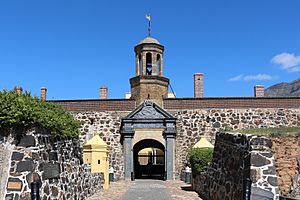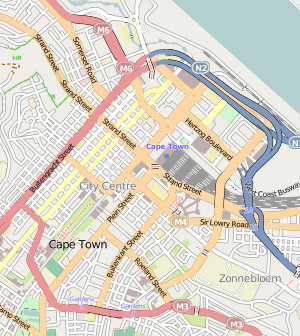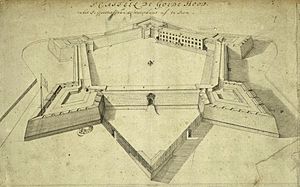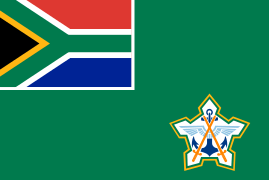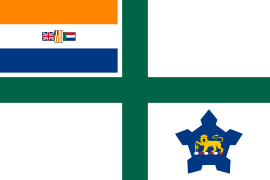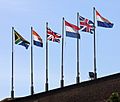Castle of Good Hope facts for kids
Quick facts for kids Castle of Good Hope |
|
|---|---|
| South Africa | |
|
Gateway to the Castle of Good Hope
|
|
|
Location in central Cape Town
|
|
| Coordinates | 33°55′33″S 18°25′40″E / 33.9259°S 18.4278°E |
| Type | Bastion fort |
| Site information | |
| Controlled by | |
| Open to the public |
Yes |
| Site history | |
| Built | 1666–1679 |
| Battles/wars | Second Boer War |
The Castle of Good Hope is an old and famous building in Cape Town, South Africa. People often call it the Castle or Cape Town Castle. It's a type of strong fort called a bastion fort.
This castle was built a long time ago, in the 1600s. It was first built right on the coast of Table Bay. But over time, more land was added, so now the castle is a bit further inland.
In 1936, the Castle became a protected historical place. After being fixed up in the 1980s, it is now the best example of a fort built by the Dutch East India Company.
Contents
History of the Castle of Good Hope
Building the Oldest Building in South Africa
The Castle of Good Hope was built by the Dutch East India Company. This powerful company built it between 1666 and 1679. It is the oldest building still standing in South Africa today.
Before this stone castle, there was an older fort. It was called the Fort de Goede Hoop. This first fort was made from clay and wood. Jan van Riebeeck built it when he arrived at the Cape of Good Hope in 1652.
The Dutch wanted a place for their ships to stop. Their ships made long, dangerous trips between the Netherlands and places like Indonesia. The Cape was a perfect spot to get supplies and rest.
Why a New Stone Fort Was Needed
In 1664, there were worries about a war between Great Britain and the Netherlands. Because of this, a new, stronger fort was needed. Commander Zacharias Wagenaer was told to build a fort made of stone.
The first stone for the new castle was placed on January 2, 1666. Building the castle took a long time. The Dutch East India Company did not always want to spend money on it.
On April 26, 1679, the five main parts of the castle were named. They were named after titles of William III of England. These names are Leerdam, Buuren, Katzenellenbogen, Nassau, and Oranje. You can still find these names used as street names in Cape Town today.
Changes and Important Features
In 1682, the main entrance of the castle was changed. It used to face the sea, but then a new gated entry was built. A tall bell tower was added above this new entrance in 1684.
The bell in the tower is the oldest in South Africa. It was made in Amsterdam in 1697. This bell weighs more than 300 kilograms (about 660 pounds)! It was used to tell the time and warn people of danger. You could hear it from 10 kilometers (about 6 miles) away. It also called people together for important announcements.
The castle was like a small town inside. It had a church, a bakery, and many workshops. There were also living areas, shops, and even prison cells. The walls inside are painted yellow. This color was chosen because it helps to keep the castle cooler in the sun.
A special wall divides the inner courtyard. This wall was built to protect people during an attack. The De Kat Balcony is also in the courtyard. This balcony was designed by Louis Michel Thibault. Important announcements were made from here to soldiers and other people living in the Cape. Today, the balcony leads to a collection of old paintings and furniture.
The Castle as a Prison
During the Second Boer War (1899–1902), parts of the castle were used as a prison. You can still see the old cells today. One famous prisoner was Fritz Joubert Duquesne. He tried to escape from the castle.
Duquesne slowly dug away the cement around the stones with an iron spoon. One night, he almost got out. But a large stone fell and trapped him in his tunnel. The next morning, a guard found him. He was unconscious but still alive.
Protecting a Historical Site
In 1936, the Castle was officially named a historical monument. This was the first place in South Africa to get this special protection. In the 1980s, the castle was carefully restored. This work made it the best-preserved example of a Dutch East India Company fort.
Today, the Castle is still important. It is the local headquarters for the South African Army in the Western Cape. It also has the Castle Military Museum. Here, you can learn about the history of the military in South Africa.
Symbolism of the Castle
The unique shape of the Castle of Good Hope is a five-sided star. This shape was used as a symbol for many years. Before 2003, you could see it on the flags of the South African Defence Force. It was also part of some military rank badges. The symbol was even used on South African Air Force aircraft.
-
Roundel of the South African Air Force from 1982 to 2003
Gallery
-
The six historical flags that have flown over the Cape, in chronological order from right to left: the Prince's Flag, the flag of Great Britain, the Batavian flag, the flag of the United Kingdom, the old South African flag, and the current South African flag
See also
 In Spanish: Castillo de Buena Esperanza para niños
In Spanish: Castillo de Buena Esperanza para niños


